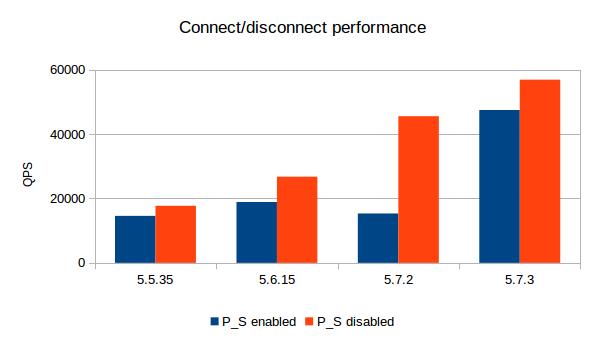In some application scenarios (e.g. PHP applications) client connections have very short durations, maybe only executing a single query. This means that the time spent processing connects and disconnects can have a large impact on the overall performance.
In MySQL 5.6 we started working on optimizing the code handling connects and disconnects. And this work has accelerated in MySQL 5.7. In this blog post I will first show the results we have achieved and then describe what we have done to get them.
The results
The graph below shows a comparison of the most recent 5.5 and 5.6 releases as well as the 5.7.2 and 5.7.3 milestones. We measured the number of queries per second (QPS) where each client executes a single query (point select) before disconnecting. For each server version we also tested with both Performance Schema disabled and enabled. Details about server hardware and configuration settings used, are given at the end of this blog post.
The results show that we have achieved a +220 % improvement compared to the current 5.5 version and a +110-150 % improvement compared to the current 5.6 version! We also have higher performance with Performance Schema on in 5.7.3, than we had with Performance Schema turned off in 5.7.2. Actually, the Performance Schema overhead for processing of connects/disconnects is lower in 5.7.3 than in both 5.5.35 and 5.6.15.
How we got them
Interestingly enough we started out by trying to fix a rare crashing bug on SPARC. Each connection is represented in the server by a THD object. These objects were organized in a global intrusive list (through inheritance) and removal from the list was done in THD’s destructor. In some rare cases and at high compiler optimization levels, the inheritance could corrupt the THD objects resulting in a crash. This crashing bug was fixed in MySQL 5.6.5.
While fixing it we realized that the destructor (because it removed itself from a global list) was called with a global mutex (LOCK_thread_count) held. Since THD is a pretty large object and the mutex is central to connects/disconnects, this was obviously not ideal. So in MySQL 5.6.6 we refactored the THD class so the destructor could be run without holding a global mutex. We also started the process of refactoring and improving the maintainability of the server code handling connects/disconnects.
Around the same time, we got a number of bugs reported related to connect/disconnects reported by Domas Mituzas from Facebook: Bug#62282, Bug#62283, Bug#62284, Bug#62285, Bug#62286. Some of them (62282 and 62285) were limited in scope, so they were implemented in 5.6.
In any case, for MySQL 5.6 our focus was on preparatory refactoring, not on performance improvements. But they did not go unnoticed, as evident by this blog post by Yoshinori Matsunobu, also from Facebook.
For MySQL 5.7.2, we made a worklog mostly based on 3 of Domas’ remaining bug reports (62283, 62284, 62288). Before this worklog, much of the initialization of new connections, including construction of the THD object, was done by the thread accepting new connections. By moving this work to the client thread, the acceptor thread was much sooner ready to accept a new connection. This worklog also included significant code refactoring – moving from C-like code to more modern C++ code.
After 5.7.2 was released, we asked our performance architect Dmitri Kravtchuk to investigate where the remaining connect/disconnect bottlenecks were. It turned out that the main bottleneck was a the LOCK_thread_count global mutex, that among other things protected the global list of connections. As a result of the refactorings we had earlier done in 5.6 and 5.7.2, it was quite easy to split this mutex so that it is no longer used for several different purposes. Now we have one mutex for the connection list, one mutex for the thread cache, use atomics for the thread ID counter, etc. Together with a minor improvement related to accounting of prepared statements, this gave us the performance improvements seen in 5.7.3.
In parallel with this work, Marc Alff has also been busy reducing performance schema overhead. Each time a client disconnects, many PFS statistics have to be maintained. Even if PFS was greatly extended in 5.6, and 5.7 so far has added e.g. memory, metadata lock and transaction instrumentation, the overhead in 5.7.3 is actually slightly lower than in 5.5!
Thanks to Vince Rezula and Avinash Potnuru for help with running performance benchmarks!
|
1 2 3 4 5 6 7 8 9 10 11 12 13 14 15 16 17 18 19 20 21 22 23 24 25 26 27 28 29 30 31 32 33 34 35 36 37 38 39 40 41 42 43 44 45 46 |
Tests executed on a server with Intel Xeon X7560 (4 sockets, 8 cores, 64 threads) @ 2.27 GHz, using the following cnf: [mysqld] back_log=24 disable-log-bin innodb_additional_mem_pool_size=20M innodb_adaptive_flushing = 1 innodb_buffer_pool_size=32000M innodb_buffer_pool_instances=32 innodb_checksums=0 innodb_data_file_path=ibdata1:2000M:autoextend innodb_doublewrite=0 innodb-file-per-table=1 innodb_flush_log_at_trx_commit=2 innodb_io_capacity=2000 innodb_max_dirty_pages_pct=50 innodb_open_files=14000 innodb_purge_threads=1 innodb_read_io_threads=16 innodb_write_io_threads=4 innodb_log_buffer_size=64M innodb_log_files_in_group=3 innodb_log_file_size=1024M innodb_spin_wait_delay=24 innodb_support_xa=0 innodb_thread_concurrency=0 innodb_use_native_aio=1 join_buffer_size=32K key_buffer_size=200M log-error=error.log loose-local-infile=1 low_priority_updates=1 max_allowed_packet=1048576 max_connections=10000 max_connect_errors=50 port=3306 performance_schema=ON sort_buffer_size=32K sql-mode="NO_ENGINE_SUBSTITUTION" table_open_cache=10000 transaction_isolation=REPEATABLE-READ query-cache-size=0 query-cache-type=0 user=root innodb_flush_method = O_DIRECT innodb_adaptive_hash_index=1 |
